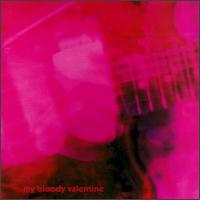My Bloody Valentine - Loveless
Review: At the turn of the decade, the pop fascination with clean sounds and rigid logical structures began to fade, and bands got noisier. At the forefront of this movement, My Bloody Valentine layered their music in waves of distortion and often sweetly dischordant seemingly chaotic background harmony, creating a sound that was as ambiguous as 1980s pop was self-evident. Historically of note is their tendency to vary up the verse-chorus structure like a metal band, often breaking into abrupt changes and using thematic bridges and introductions.
These soaring streams of sound are formed from several guitars playing at once, some detuned and using the trademark sweep of whammy bar style that allows insane tone-stalling bending sounds; distortion permeates each layer to varying degrees, and together it forms an ethereal mass in which one voice can be heard clearly as others quirkly flit around it like tangential angels. Much as Darkthrone and Burzum created similar wave of sound techniques, the surging and ebbing subdued throb of this music drapes rhythm and melody in an often ambiguous harmony, leaving several voices at once interacting through a meta-distortion of contrast. The effect is breathtakingly beautiful, and when immersed in the lush pop hooks and sweetly feminine vocals this band employ as weaponry, endows the listening experience with a sense of wanderlust and melancholy that is rare in radio-play music.
Song structure expands with introductions to each piece, seemingly careless detours into harmonic dark space implied in counterpoint to stronger minor-key foundations expressed between vocals and dominant guitar voice, and recursive patterns of relocation of phrase which appear arbitrary in their return to verse or chorus until complemented by a summarizing theme. What limits this band is its pop nature, where the better black metal had a greater range of mood, but within that context it fosters a poignant ferment of feeling that resolves its own conflict in uncertainty, distinguishing itself among the dogmatic monochrome of feeling typical of that genre.
